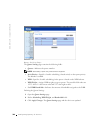
Configuring Quality of Service 337
QoS includes traffic such as voice, video, and real-time traffic that can be assigned a high
priority queue, while other traffic can be assigned a lower priority queue. The result is an
improved traffic flow for traffic with high demand.
QoS is defined by:
• Classification—Specifies which packet fields are matched to specific values. All
packets matching the user-defined specifications are classified together.
• Action—Defines traffic management where packets being forwarded are based on
packet information, and packet field values such as VLAN priority (VPT) and DSCP
(DiffServ Code Point).
• Prioritization—Traffic is assigned a priority and queued on the appropriate queue for
forwarding.
Class of Service (CoS) Information
Eight CoS values can be mapped to one of four forwarding queues (queue 1 to 4). Each
queue has a different priority. The first queue has the lowest forwarding priority, while the
fourth queue has the highest forwarding priority and is not mapped by default.
NOTE: In a stacking configuration, Queue 4 is used for forwarding stacking traffic. Therefore,
assigning additional traffic to Queue 4 may interfere with stack control.
There are three mapping tables:
• CoS to Queue Mapping Table.
• DSCP to Queue Mapping Table.
• TCP/UDP to Queue Mapping Table. The TCP/UDP table is empty by default.
The Cos to Queue Mapping Table has default CoS mapping to forwarding queue values:
CoS Value Forwarding Queue Values
0q2
1 q1 (Lowest Priority = Best Effort)
2 q1 (Lowest Priority = Best Effort)
3q2
4q2
5q3
6q3


















